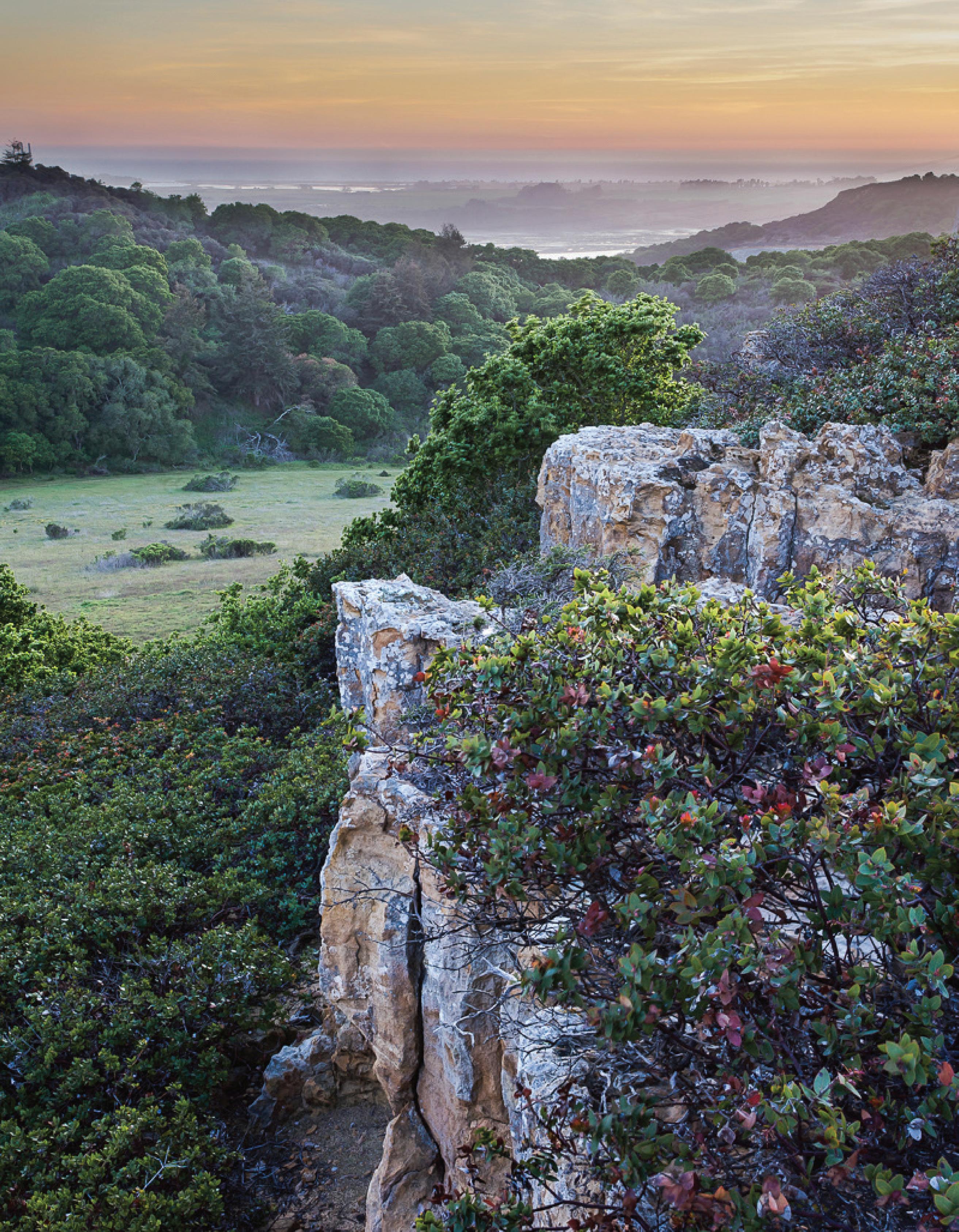

Tidal Exchange





Watershed Moments
Highlights of Our Year in Conservation


As 2018 draws to a close and we turn the page to a new year, we also re ect on a year of watershed moments for the Elkhorn Slough and its surrounding lands. is was a year of awards and accolades, a year of growth and change, and a year of partnerships and innovation.

(Continued on page 4)

Elkhorn Slough Foundation
Anne Olsen
President
Robert Hartmann
Vice President
C. Michael Pinto
Treasurer
Bruce Welden
Secretary
Judith Connor
Past President
Gary Bloom
Ed Boutonnet
Terry Eckhardt
Sandy Hale
Kent Marshall
Murry Schekman
Anne Secker
Laura Solorio, MD
Tara Trautch
Mark Silberstein
Executive Director
e mission of the Elkhorn Slough Foundation is to conserve and restore Elkhorn Slough and its watershed.
We see Elkhorn Slough and its watershed protected forever— a working landscape, where people, farming, industry, and nature thrive together. As one of California’s last great coastal wetlands, Elkhorn Slough will remain a wellspring of life and a source of inspiration for generations to come
PO Box 267, Moss Landing California 95039
tel: (831) 728-5939
fax: (831) 728-7031
www.elkhornslough.org

updates from the reserve

See What’s New at the Slough!
is has been a busy and productive year for the sta at the Elkhorn Slough National Estuarine Research Reserve.
Education Coordinator Virginia Guhin and all-around construction master
Mike Curthoys oversaw the design and installation of the new entryway to the Reserve. Now sta , volunteers, and visitors now enjoy the beauty and ease of the redesigned gate.
Virginia is also leading the renovation of the Reserve amphitheater, the parking lot and an outdoor gathering area for visiting students.
Mike worked with Manager Dave Feliz and Reserve sta to create a freshwater pond and pathway below the Visitor Center that almost immediately attracted frogs, ducks, and other freshwater life. It now houses a wayward
Scott Nichols, Editor
Foundation
updates from the reserve
Oyster Restoration & Aquaculture
On October 23, a new generation of Olympia oysters settled into their home on the tide ats of the Elkhorn Slough Reserve. Scientists at Moss Landing Marine Laboratories raised these baby oysters at their new Aquaculture Facility, with a grant from the Anthropocene Institute and support from California Sea Grant. e collaboration is the rst attempt to support native oyster restoration through aquaculture in California.
Why were these baby oysters grown in the lab?
“In all the years I’ve been monitoring slough oysters, we only had a good crop of new juveniles twice, once in 2007 and again in 2012,” explains Reserve Research Coordinator Kerstin Wasson. “Elkhorn Slough’s native oyster population is at risk of disappearing entirely. Native American middens and paleo-ecological data show oysters have lived in the estuary for ten thousand years. I don’t want to lose them on my watch.”
e team readied about 2,500 juvenile oysters for the e ort — 10 times the number of oysters surveyed in the area where Kerstin and her colleagues would transplant the new recruits. Past data suggest that oysters, once settled, grow and survive quite well.
While the exact cause for the oysters’ reproductive failure is unknown, alterations to tidal ow may be a contributing factor. Wasson conducted a comparative study with researchers along more than 1,500 miles of coastline, published in the journal Ecology ey found high failure rates in estuaries with small remaining oyster populations and strong marine in uence, resulting in cold waters and larvae being swept out to sea.
“Linking oyster restoration to aquaculture may be the answer to saving this species in Elkhorn Slough and other highly altered estuaries,” says Reserve Manager Dave Feliz. Meanwhile, we are cheering on these young oysters and look forward to expanded oyster reefs in time. ■

Western pond turtle rescued from the road. e Elkhorn Slough National Estuarine Research Reserve serves as a hub for programs in and access to the slough and has become an iconic stop along the California coast. Come and visit! ■
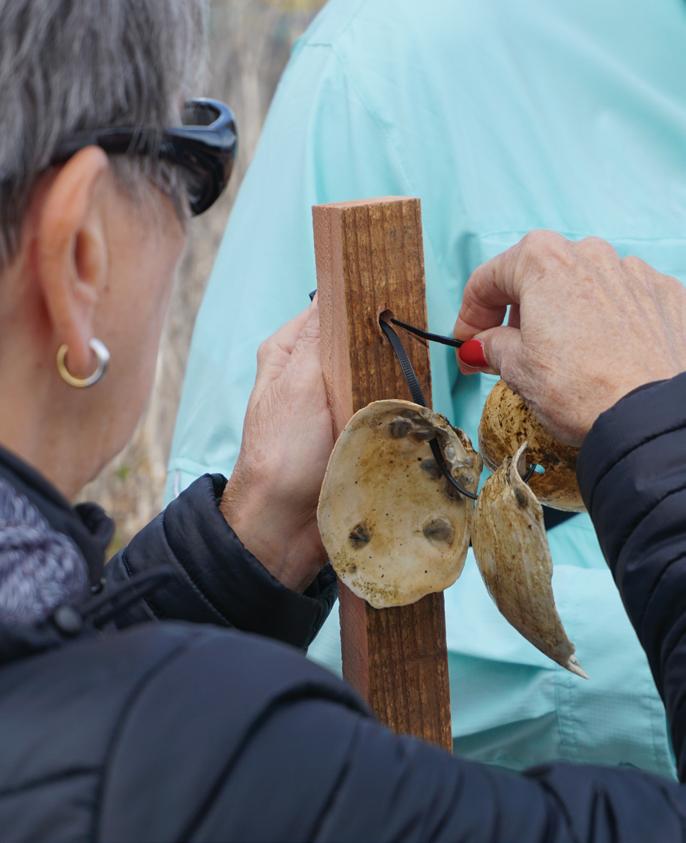
Reserachers, students, and volunteers prepare clamshells stakes — speckled with lab-grown Olympia oysters — for outplanting in the mud ats of the Elkhorn Slough Reserve.

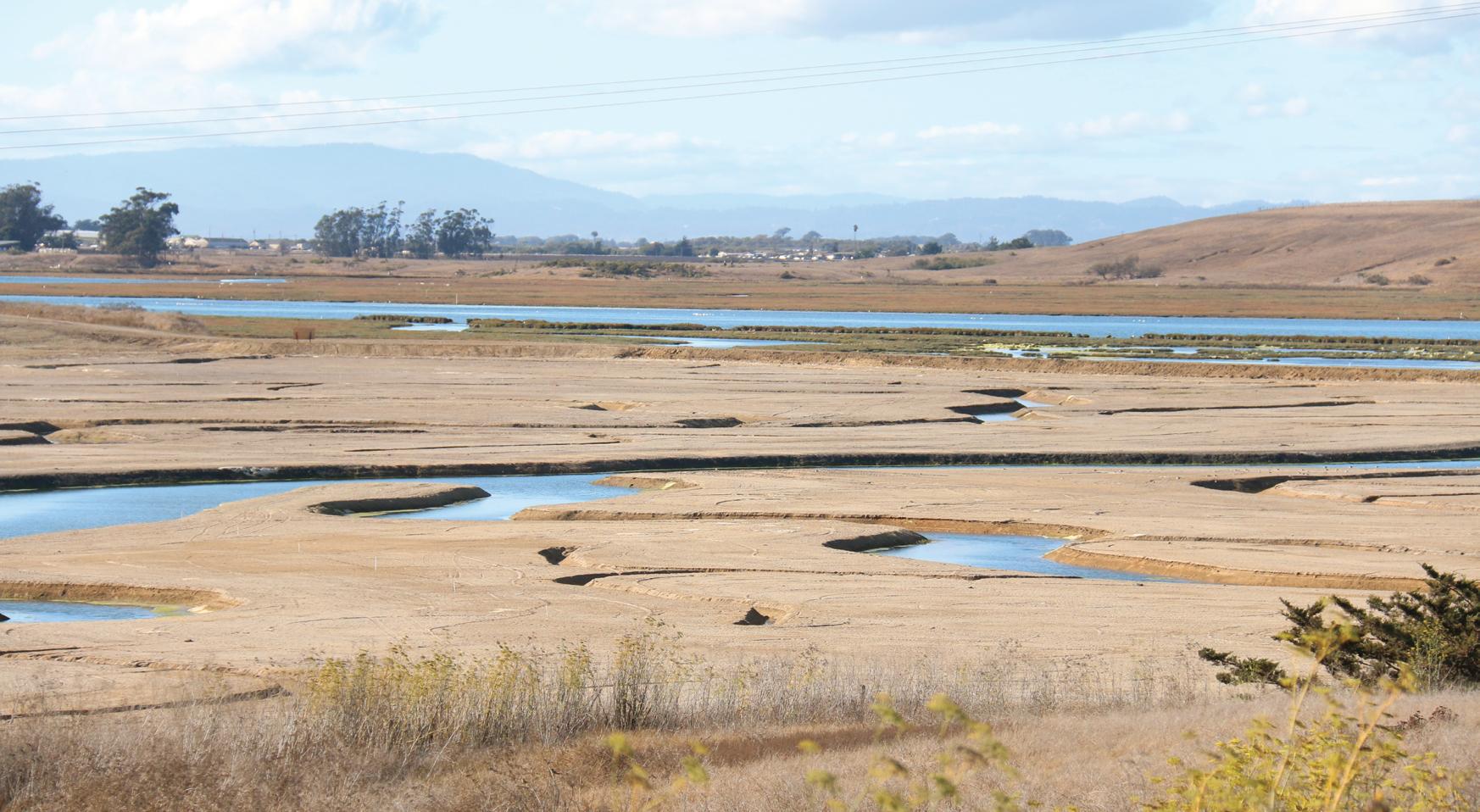
Hester Marsh
Marsh Plants Starting to Take Root

Elkhorn Slough’s Tidal Wetland Program has been active for fourteen years and sta , scientists and managers have expanded their understanding of this habitat along with implementing major projects to sustain the productivity and beauty of these coastal marshes. Meticulous study revealed that marshes in some stretches of the slough are not keeping up with rising sea level. Researchers have also identi ed areas of marsh that were historically diked o , dried and put to other uses before the levees eroded and the areas returned to tidal ow. ese areas sank up to several feet below their original elevation — below the depth where marsh plants could survive when the areas were opened to the tides.
We reported last spring on the Hester Marsh — 61 acres of diked and drowned marshes that are being restored. Hester Marsh was diked and drained for farming during the last century, resulting in a sunken marsh elevation too low to support the owering plants that make up salt marsh. e restoration brought in sediment and raised the site elevation by several feet to support tidal marsh habitat that will withstand changes in sea level for the next century.
e restoration is taking advantage of the fact that the seeds of many of the species of tidal marsh plants oat and are distributed by the tide. e area was opened just as the fall high tides owed in. We are eagerly watching for the seeds to take root and Hester Marsh to turn green. With the productivity and stability of the marsh, will come the biology: shes, birds, invertebrates and our otter pals. Hester Marsh doubles the area now intensively used by sea otters and pups and we’ve already seen otters exploring the new channels. Stay tuned! ■










Earthmoving is complete for this phase of the Hester Marsh restoration (top, by Hazel Rodriguez/USFWS); now researchers monitor the growth of marsh plants arriving on the tides, while stewards and volunteers plant saltgrass and other hardy native plants in the ecotone between wetlands and uplands.
Photo by Erica Parker
Photo by Brendan Tougher

Watershed Moments
(Continued from cover)
anks to the help of our generous members and supporters, the Elkhorn Slough Foundation expanded the lands we conserve, restored habitat for native plants and wildlife, and enhanced community outreach and educational partnerships with the people who love this special place from the ridgeline to the tideline. A few of the year’s highlights include:


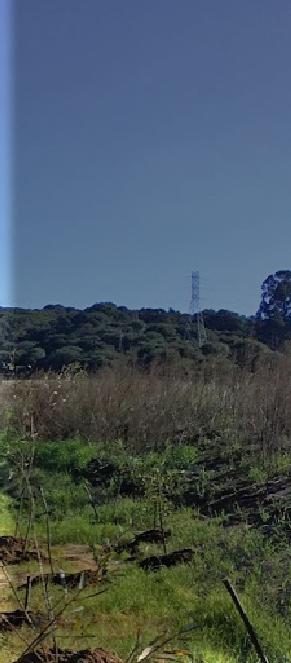


• Elkhorn Slough was designated a “Wetland of International Importance” under the Ramsar Convention (see story on page 6.)
• Reserve Research Coordinator Dr. Kerstin Wasson was honored by the Environmental Law Institute with the prestigious “National Wetlands Award for Research.”
• Paulina Salinas-Ruiz, graduate student in Marine Science at California State University Monterey Bay received ESF’s Jim Rote Scholarship in support of her innovative work on crowdsourcing diver data.

• ESF’s Les Strnad Scholarship funded 18 young students from the CHISPA Community to participate in the Camp SEA Lab summer day camp at the coast.
• e Foundation took title to the 167-acre Elkhorn Highlands Reserve, an ecologically rich property secured as mitigation for impacts of Highway 101 safety improvements by Caltrans.


• ESF’s Carneros Creek Outdoor Classroom expanded in scope, hosting 90 fourth-grade students from Hall District Elementary who participated in hands-on science and shared the Outdoor Classroom with the younger grades.
Elkhorn Highlands Reserve,
photo by Nicoletta Lanese
Photo by John Haskins/ESNERR
• e Sand Hill Farm property continued on the trajectory of restoration and habitat improvement. Community volunteers planted hundreds of coast live oaks and arroyo willows to restore woodlands and limit erosion from steep, sandy slopes.
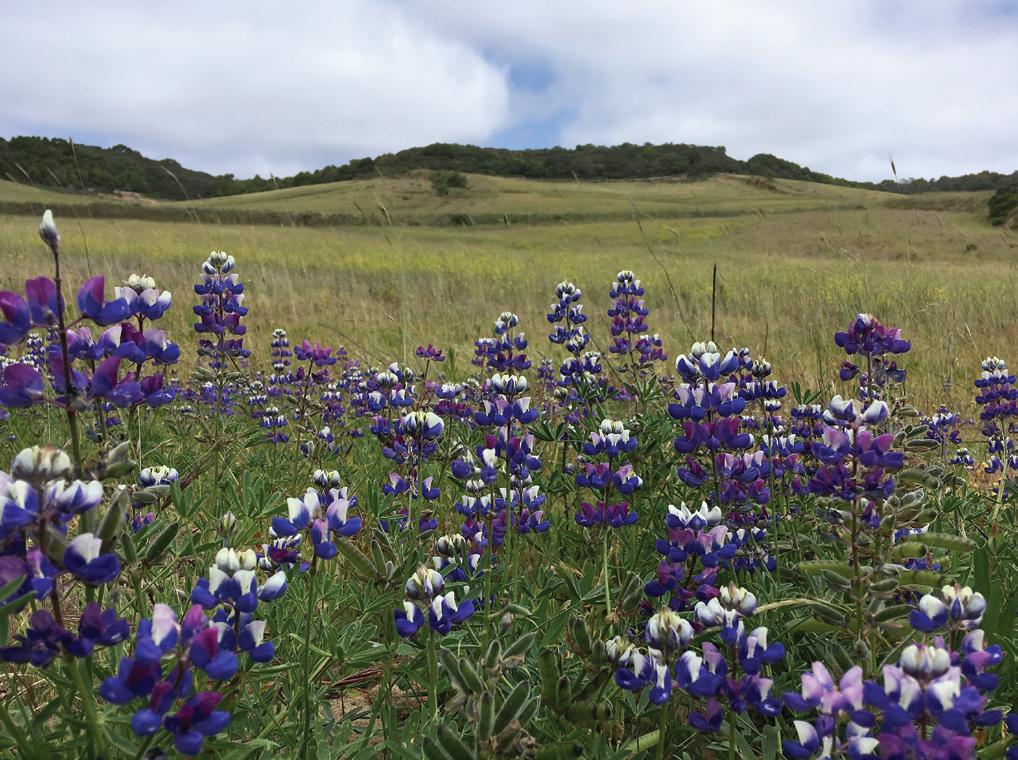

• Hester Marsh construction complete — more than 200,000 tons of earth were placed to restore healthy tidal marsh in a part of the slough that is heavily used by sea otter moms and pups (see story on page 3.)


Create Wildlife Corridors & Boost Your Support with MC Gives!
e Elkhorn Slough is known for its large population of Southern sea otters, and we’ve worked with our partners to protect and enhance the aquatic side of the slough that sustains these otters. As the Elkhorn Slough Foundation works to protect the waterway and its wildlife habitat, we have acquired thousands of acres of contiguous land on the hills surrounding the slough. Deer, bobcats, mountain lions, quail, coyotes, and other animals roam these hillside meadows and woodlands. Restoring and caring for the land is creating expanded and healthier habitat for the wildlife that calls our watershed home.

• e original Elkhorn Slough Ottercam was out tted with sound to accompany the high de nition streaming video. Early audio: an otter pup calling for its mother.
We look forward to the coming year with great enthusiasm and energy — and to seeing you at the Slough! ■



We have opened up wildlife corridors to encourage movement and connectivity. One of our key funding campaigns this year focuses on enhancing upland wildlife habitat. We will build sustainable, rainfed watering holes (guiding animals away from residential areas), remove remnant barbed-wire fencing and other obstacles that can injure or impede the movement of animals, add nest boxes for woodland birds, and install wildlife cameras to monitor activity following these enhancements.
As an accredited land trust, the Elkhorn Slough Foundation is responsible for the care and conservation of our protected lands in perpetuity. Our stewardship work involves annual tasks, such as mowing, weed abatement, and erosion control, as well as special large-scale restoration projects.
With your support, we move beyond the ordinary and invest in sustaining upland wildlife. e Monterey County Gives campaign (montereycountygives.com/nonprofit/elkhorn-slough-foundation) runs through December 31, and is an easy and e ective way to leverage your donation with matching funds to help ESF protect wildlife at the slough. And, of course, it’s never too late to make a contribution on our website — www.elkhornslough.org. ■

by Molly McCorkell
Bobcat,
photo by Malone Hodges

Elkhorn Slough Wetland of International Importance
On October 5, a group of friends, partners, and dignitaries assembled at the Elkhorn Slough Reserve’s Hester Marsh to celebrate the designation of Elkhorn Slough as a “Wetland of International Importance” by the Secretariat of the Ramsar Convention on Wetlands.
With this recognition, the Elkhorn Slough joins 38 other wetland sites in the United States — including the San Francisco Bay estuary — and more than 2,330 sites worldwide, in a network of globally important wetlands designated under the world’s oldest international environmental treaty.
To be designated a “Wetland of International Importance,” a wetland area must ful ll at least one of nine criteria, including hosting more than 20,000 shorebirds at a time, serving as sh nursery habitat, and supporting threatened species. Elkhorn Slough met all nine.

CRITERION 1:
Unique natural or nearnatural wetland types
Elkhorn Slough is the largest estuary along hundreds of miles of central California coast, and hosts the largest salt marsh in California south of San Francisco Bay, as well as extensive mud ats and eelgrass beds.



of the U.S. Fish and Wildlife Service Paci c Southwest Region. “ e rich and diverse ecosystems of Elkhorn Slough help both our wildlife and our local communities thrive.”
Wetlands like Elkhorn Slough serve key functions in pollution control and food provision, o ering green, sustainable, low cost and e cient ways to clean wastewater of impurities and recycle nutrients, and serve as cradles of biodiversity by hosting young sh and other marine species — all of which are critical to the food chain for humans and wildlife worldwide.
“Healthy wetlands help support healthy economies,”
said Paul Souza, regional director
CRITERION 2:
“I am proud that Elkhorn Slough is being recognized internationally for what we on the central coast of California have long known, that this wetland is an environmental crown jewel. is designation is a reminder of the importance of protecting the diverse wildlife and conserving these waters for future generations to enjoy,” said Congressman Jimmy Panetta. ■

Rare species & threatened ecological communities
Elkhorn Slough is critical for two threatened species— Southern sea otters and snowy plovers — and three threatened communities— salt marsh, eelgrass beds, and oyster beds.
CRITERION 3:
Biological diversity
Elkhorn Slough hosts more than 500 invertebrate, 100 sh, and 300 bird species.
CRITERION 4:
Support during critical life stages or in adverse conditions
Elkhorn Slough is a critical stopover for migratory waterbirds on the Paci c Flyway, supports the highest density of threatened Southern sea otter pups, hosts a signi cant portion of nests of threatened Western snowy plovers, and serves as a key nursery for English Sole, a commercially valuable species.
Snowy plover chick,
photo by Mark Holsapple
A few of the friends celebrating Elkhorn Slough’s designation as a “Wetland of International Importance” included (from left to right) USFWS Paci c Southwest Deputy Regional Director Jody Holzworth, State Senator Bill Monning, ESF Executive Director Mark Silberstein, Assemblymember Mark Stone, Reserve Manager Dave Feliz, Monterey County Supervisor John Phillips, former County Supervisor and ESF founding board member Lou Calcagno, Congressman Jimmy Panetta, and NOAA National Ocean Service Acting Director Nicole leBoeuf. (photo by Hazel Rodriguez/USFWS)

CRITERION 5:
More than 20,000 waterbirds
Our fall monitoring surveys routinely record >20,000 waterbirds in Elkhorn Slough.
CRITERION 6:
More than 1% of waterbird populations
Elkhorn Slough typically hosts >2% of the nests of threatened Western snowy plovers, and 5-6% of the total migratory shorebirds counted on the Paci c Flyway.
CRITERION 7: Signi cant & representative sh
Elkhorn Slough has 100 sh species in 43 families, and as the only large estuary in the region, provides critical sh habitat.
CRITERION 8:

Kirsten
Fish spawning grounds
Elkhorn Slough is designated as Essential Fish Habitat and a Habitat Area of Particular Concern for various sh species life stages managed under the Coastal Pelagic and Paci c Ground sh Fisheries Management Plans of the National Marine Fisheries Service. Recent studies have shown that English Sole that spent their juvenile period in Elkhorn Slough contribute disproportionately more to the o shore catch of adults in Monterey Bay.


slough view
Working Together
Mark Silberstein, ESF Executive Director
is spring marked the 36th year of the Elkhorn Slough Foundation. In 2019, we’ll celebrate the 40th anniversary of Elkhorn Slough being designated a National Estuarine Research Reserve.
e strong partnerships that evolved between the California Department of Fish and Wildlife, the National Oceanic and Atmospheric Administration and the Elkhorn Slough Foundation has served as a model for other sites around the country. Being embedded in the network of 29 National Estuarine Research Reserves around the country brings a depth and breadth of connection and experience that a solitary site would not have. ese connections have strengthened both the Elkhorn Slough Foundation and the Reserve and opened opportunities that are not readily available to most community organizations. e network of Reserves is powerful.
CRITERION 9:
More than 1% of non-avian populations
Elkhorn Slough provides very important foraging, resting, and nursery areas for Southern sea otters, and about 3% of the population is typically found within the estuary.
e Foundation is also engaged in the larger community of land trusts as a member of the national Land Trust Alliance, as an Accredited Land Trust through the Land Trust Accreditation Commission, and as a founding and active member of the California Council of Land Trusts. ese overlapping associations connect the Slough to cutting edge approaches to conservation and stewardship and are one of the reasons for the conservation progress enjoyed here.
Yet one of the most critical components in this trajectory of accomplishments is you! Community support has been both the hallmark and the motive force behind slough conservation. So as we begin a new year, we simply want to thank you for your ongoing interest and investment. ■
by
Marbled godwit, photo by Virginia Hayes
English sole, photo by
Ramey/CDFW
Elkhorn Slough Foundation
P.O. Box 267
Moss Landing, CA 95039
Elkhorn Slough Reserve is open to the public Wednesday through Sunday, 9 am to 5 pm. We hope you’ll join us for a visit or an event. For more information, visit www.elkhornslough.org.
Every Saturday & Sunday: Reserve Tours Join knowledgeable docents for tours of the Reserve at 10 am & 1 pm
First Saturday every month, 8:30am: “Early Bird” Walks With local birding expert Rick Fournier. Meet at the Reserve at 8:30 am
Second Sunday every month, 2pm: “Slough & Easy” Walks Call the Elkhorn Slough Reserve at 831.728.2822 for more information.
January 20: Annual King Tide Walk
Witness one of the year's highest tides while helping California scientists
January 23: Volunteer Information Night
Discover ways to lend your hand to the Elkhorn Slough
January 26-February 23: Docent Training Build your knowledge of natural history and join the Reserve’s team of interpretive docents
Check our online event calendar for details about other upcoming walks, talks and outings!













Free Elkhorn Slough Calendar with Gift Membership!
Now through February 2019, with every gift membership of $35 or more you give, we’ll send your recipient a complimentary, full-color Elkhorn Slough calendar. Support the place you love and share it with someone special — give a gift membership today at www.elkhornslough.org!
Visit ElkhornSlough.org and follow us on Facebook & Twitter for news and updates on upcoming events and more!


Front cover: Brothers Ranch is one part of a 3-mile contiguous corridor of ESF-protected lands (photo by Paul Zaretsky)
